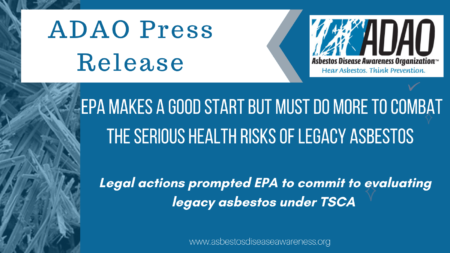FOR IMMEDIATE RELEASE
March 1, 2022
EPA MAKES A GOOD START BUT MUST DO MORE TO COMBAT THE SERIOUS HEALTH RISKS OF LEGACY ASBESTOS
Legal actions prompted EPA to commit to evaluating legacy asbestos under TSCA
 Washington, DC — Today the Asbestos Disease Awareness Organization (ADAO), an independent nonprofit dedicated to preventing asbestos exposure through education, advocacy, and community work, filed detailed comments on the draft scoping document for EPA’s Part 2 asbestos risk evaluation, which addresses the threat of ongoing use and disposal of the “legacy” asbestos which remains embedded in buildings, infrastructure and products across the United States. The goal of ADAO’s comments is to help EPA strengthen the foundation for Part 2 risk evaluation and deliver a robust and health-protective final document.
Washington, DC — Today the Asbestos Disease Awareness Organization (ADAO), an independent nonprofit dedicated to preventing asbestos exposure through education, advocacy, and community work, filed detailed comments on the draft scoping document for EPA’s Part 2 asbestos risk evaluation, which addresses the threat of ongoing use and disposal of the “legacy” asbestos which remains embedded in buildings, infrastructure and products across the United States. The goal of ADAO’s comments is to help EPA strengthen the foundation for Part 2 risk evaluation and deliver a robust and health-protective final document.
“EPA’s draft scoping document is a critical step in fulfilling its long-delayed obligation to evaluate the risks of legacy asbestos under the Toxic Substances Control Act (TSCA),” commented ADAO president and co-founder Linda Reinstein. “However, we are concerned that the document does not reflect a full understanding of the broad range of legacy asbestos uses and related pathways of exposure. It also lacks the analytical tools and necessary data to effectively assess legacy asbestos risks,” she continued.
Asbestos is a known carcinogen that kills nearly 40,000 Americans each year. There is no safe level of exposure to asbestos. Exposure to asbestos causes fatal diseases including mesothelioma and cancers of the lung, larynx, and ovaries.
Legacy asbestos, or asbestos used in products and construction materials over the last century, continues to pose a serious threat to public health and is a major contributor to asbestos-caused disease and death. Workers and consumers are exposed to legacy asbestos during the ongoing use, structural renovation, repair or demolition, and disposal of asbestos-containing materials.
“The agency’s scoping document builds on and implements the settlements reached earlier this year in two cases filed by ADAO and several public health organizations and leading asbestos scientists,” noted ADAO counsel Bob Sussman. “If EPA carries out the commitments they agreed to in these settlements, it will help ensure the Part 2 evaluation is comprehensive under TSCA, addresses all hazards and pathways of exposure, and is completed without further delay,” he concluded.
Under a consent decree negotiated by EPA and ADAO, the Part 2 risk evaluation must be completed by December 1, 2024. It is one of many ways legal actions by ADAO have held EPA accountable for its responsibility under TSCA to protect public health from toxic asbestos.
“As EPA continues its work, Congress can and should put an end to the importation and use of asbestos in the United States with a ban,” stated Reinstein ”This is the fastest and most effective way to prevent unnecessary loss of life from importation and ongoing use of asbestos,” she concluded.
###
About the Asbestos Disease Awareness Organization
Founded in 2004, the Asbestos Disease Awareness Organization (ADAO) is the largest independent 501(c)(3) nonprofit in the U.S. dedicated to preventing asbestos exposure to eliminate asbestos-related diseases through education, advocacy and community initiatives. For more information, visit www.asbestosdiseaseawareness.org. ADAO, a registered 501(c)(3) nonprofit organization, does not make legal referrals.
